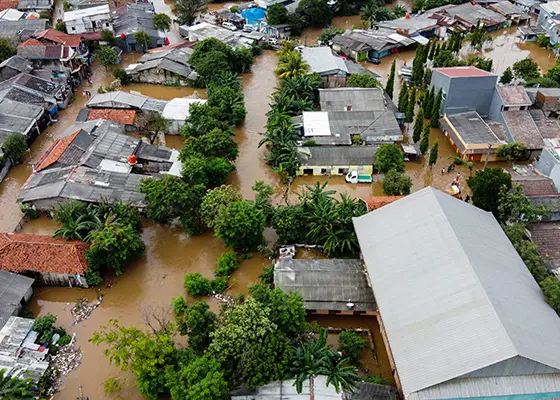The month of July has been a tough one for Texas businesses. July 8, Hurricane Beryl swept through Texas, leaving a trail of destruction in its wake. Many businesses were caught off guard and unprepared for the consequences such as power outages and damaged infrastructure. More than 2 million people were left without power and there was more than $3 billion in damages caused by the storm. Just when we thought we were past that, the CrowdStrike issue appeared and crippled organizations across the globe. These events have served as a wakeup call about the importance of a Business Disaster Recovery Plan
Whether the issue is natural or technical, the impact of a business disaster can be devastating. 40% of small businesses that close in the wake of a disaster never reopen . That’s why having a well-thought-out and comprehensive Business Disaster Recovery Plan is crucial for any organization, particularly considering recent disasters.
As things shift back to normal, now is the time to review how your business weathered the storm. Understanding the essential components of a BDRP will help your organization stay ahead of the curve during future events.
What is a Business Disaster Recovery Plan?
A Business Disaster Recovery Plan (BDRP) is a strategic approach that outlines the processes and procedures a company will follow to maintain and restore operations in the event of a disaster. It helps ensure business continuity, protect critical data, and maintain stakeholder confidence in the face of adversity. The plan typically covers multiple scenarios, including natural disasters, cyber-attacks, and other unexpected disruptions. It asks and answers tough questions ahead of time to minimize down time and financial losses, protect your data and intellectual property, maintain customer trust and ensure employee safety and morale during a crisis.

Understanding the Essentials of a Business Disaster Recovery Plan
Only 54% of organizations have an established, company-wide disaster recovery plan. Yet, they are crucial to surviving a disaster. A BDRP serves as your company’s blueprint for navigating through a catastrophe. It answers the following questions for each potential disaster that your business could potentially face:
- What types of events could affect our business, employees and customers?
- What are the potential impacts of this occurrence?
- What will we do ahead of the crisis?
- How will we respond during this type of occurrence?
- What will we do after the event?
Answering these tough questions ahead of time ensures that operations continue without issue during an event, or resume quickly and efficiently post-crisis. Thinking ahead about these things can be crucial for a business to survive a tough situation without going under. It can help avoid financial troubles, get things running again quickly, protect the business’s good name, and even save people’s lives in very bad situations. Keeping a BDRP detailed and up-to-date turns a sudden crisis into something you can handle.
Thinking Through Potential Disasters
Thinking through potential disasters for an organization involves a systematic approach to identify, evaluate, and plan for various risks. Here are some steps businesses can take to think through potential disasters:
- Risk Identification:
- Brainstorming Sessions: Gather key stakeholders to brainstorm potential disasters that could impact the business. Consider natural, technological, and human-induced events.
- Historical Data Review: Analyze historical data of past incidents within the organization and industry to identify common risks.
- Industry Analysis: Look at similar businesses and industries to identify risks that have affected them.
- Consult Professionals: Engage with disaster recovery experts, insurance providers, and other professionals to gain insights and improve preparedness strategies.
- Risk Assessment:
- Likelihood Analysis: Evaluate the probability of each identified risk occurring.
- Impact Analysis: Assess the potential impact on business operations, financial health, reputation, and safety. Consider both short-term and long-term effects.
- Business Impact Analysis (BIA):
- Critical Functions Identification: Identify and prioritize critical business functions that are essential for the organization’s survival.
- Downtime Tolerance: Determine the maximum acceptable downtime for each critical function.
- Resource Requirements: Identify the resources (personnel, technology, information) necessary to support critical functions during a disruption.
- Scenario Planning:
- Develop Scenarios: Create detailed scenarios for each identified risk, outlining the sequence of events and potential consequences.
- Analyze Scenarios: Evaluate the scenarios to understand how they could impact the organization and what responses would be necessary.
By systematically identifying, assessing, and planning for potential disasters, businesses can enhance their resilience and ensure they are better prepared to respond to and recover from unexpected events. This proactive approach helps to protect the organization’s assets, maintain operations, and safeguard stakeholders’ interests.

Determining Impacts of Potential Disasters
Determining the impacts of potential disasters means conducting a Business Impact Analysis (BIA) that quantifies the potential consequences of each identified risk.
To begin, an organization must determine all critical business functions that are essential for the organization’s operations. Does your business have a server that is hosting business critical applications? What about your phones or email? Does your organization has a fleet of vehicles that you rely on?
Once identified, prioritize the functions based on their importance to the business and the consequences of their disruption. If you lost your servers and your phone system due to a natural disaster, which would be most important to get up first?
After each business function is prioritized, it's important to define how a disaster would affect each of them in these core areas:
- Operational Impact: Will it affect day-to-day operations.
- Financial Impact: How will it affect you financially? Will it including revenue loss, increased costs, and penalties?
- Reputation Impact: If this disaster happened, will affect the company’s reputation and customer trust?
- Legal and Regulatory Impact: What are the legal and regulatory consequences of this disaster? Will there be fines? Are there compliance issues?
- Health and Safety Impact: What is the risks to employee and customer health and safety?
Once you have defined the affects, it's time to quantify them.
This analysis should encompass both direct and indirect effects, ranging from immediate operational hurdles to longer-term brand damage. This can be measured by determining the downtime costs, recovery costs, and intangible costs.
- Downtime: What is the cost per hour for your business to be unavailable? Consider lost sales, decreased productivity, and overtime pay. Once you’ve determined the cost per hour, it’s time to estimate the number of hours you would be down due to the particular disaster you are considering. For each of the scenarios, it’s important to determine the maximum acceptable downtime for each critical function before significant impact occurs.
- Recovery costs: What are the costs associated with recovery efforts? How much will repairs cost? What about replacements? Are there third-party services that would be needed for this disaster?
- Intangible Costs: Intangible costs include things that are not phsyical assets, but still critical to your business. What will this do to your organization’s reputation and customer relationships. You can quantify the intangible costs by determining your average sale and multiplying that number by the number of customers you would lose because of this disaster.
What to do before a crisis
To effectively manage a crisis, businesses should ask and answer a series of questions before the event that help prepare, respond, and recover business activities. By answering these questions before a crisis, businesses can enhance their preparedness, improve their response capabilities, and ensure a more effective recovery. This proactive approach helps minimize the impact of the crisis and supports the long-term resilience of the organization. When thinking through the process, It’s important to answer these questions for each portion of the disaster:
- Preparedness Planning:
- Have we identified and documented the roles and responsibilities of the crisis management team?
- Are our data backup and recovery processes reliable and tested regularly?
- Have we conducted risk assessments and business impact analyses (BIA)?
- Communication:
- Do we have a clear communication plan for internal and external stakeholders?
- Are contact lists for employees, emergency services, customers, and suppliers up-to-date?
- Do we have pre-drafted communication templates for various types of crises?
- Training and Drills:
- Have employees been trained on their roles and responsibilities during a crisis?
- Have we conducted regular drills and simulations to test our response plans?
- Resource Allocation:
- Do we have the necessary resources (financial, technological, human) to manage a crisis?
- Have we established relationships with external vendors and partners who can assist during a crisis?
Once you have established a clear and comprehensive emergency preparedness it’s imperative to conduct regular training sessions to reinforce these procedures.

Executing the BDRP
During a crisis, it’s time to activate your Business Disaster Recovery Plan.Your immediate focus should be on ensuring the safety of all employees, followed by maintaining critical business operations. Utilize established communication channels to provide regular updates to employees and customers, keeping them informed of the situation, how it affects operations, and what measures are being taken to address the issue. Transparency during this time builds trust and demonstrates your commitment to stakeholders’ well-being.
- Immediate Response:
- What immediate actions need to be taken to ensure the safety of employees and customers?
- How can we quickly assess the scope and impact of the crisis?
- Who should be notified immediately (employees, emergency services, stakeholders)?
- Crisis Management Team:
- Is the crisis management team fully mobilized and functioning effectively?
- Are roles and responsibilities clearly defined and being followed?
- Are there any gaps in the response that need to be addressed?
- Communication:
- How can we provide accurate and timely information to all stakeholders?
- Are we keeping employees informed about the status of the crisis and the actions being taken?
- How are we managing communication with customers, suppliers, and the media?
- Operational Continuity:
- What measures can we take to maintain or quickly restore critical business functions?
- How are we ensuring the availability of essential resources and services?
- Are alternative work arrangements (e.g., remote work) being effectively implemented?
- Documentation and Monitoring:
- Are we documenting all actions taken and decisions made during the crisis?
- How are we monitoring the situation and adjusting our response as needed?
What happens after a crisis?
After a crisis, assess the damage and begin the recovery process as outlined in your BDRP. Continue to communicate openly with employees and customers about recovery efforts, timelines for restoring services, and any changes to operations. Gathering feedback on the response efforts and identifying areas for improvement are crucial steps to refine your plan and enhance resilience for future disasters. Engaging with employees and customers throughout these phases not only aids in minimizing damage but also supports a stronger, more united path to recovery.
- Recovery and Restoration:
- What steps are necessary to fully restore business operations?
- How can we address any ongoing issues or challenges resulting from the crisis?
- Are there any long-term impacts that need to be managed?
- Evaluation and Analysis:
- What were the key successes and failures in our response to the crisis?
- How effective were our communication and coordination efforts?
- What lessons can we learn from the crisis to improve our preparedness and response plans?
- Communication and Reporting:
- How can we communicate the recovery status and any changes to stakeholders?
- Are there any legal or regulatory reporting requirements that we need to fulfill?
- How do we manage post-crisis communication with customers and the public?
- Support and Well-being:
- How can we support the emotional and psychological well-being of employees affected by the crisis?
- Are there any additional resources or support systems needed for recovery?
Partnering with Experts for Enhanced Resilience
Partnering with disaster recovery experts, IT consultants, and insurance providers is key to enhancing business resilience. Such collaborations offer access to specialized services and advice, crucial for developing robust preparedness strategies. This ensures a smoother recovery process, enhances operational continuity, and secures the business’s future against unforeseen challenges. If your organization needs help with your data recovery plan, contact IT Enabled. We can help!
